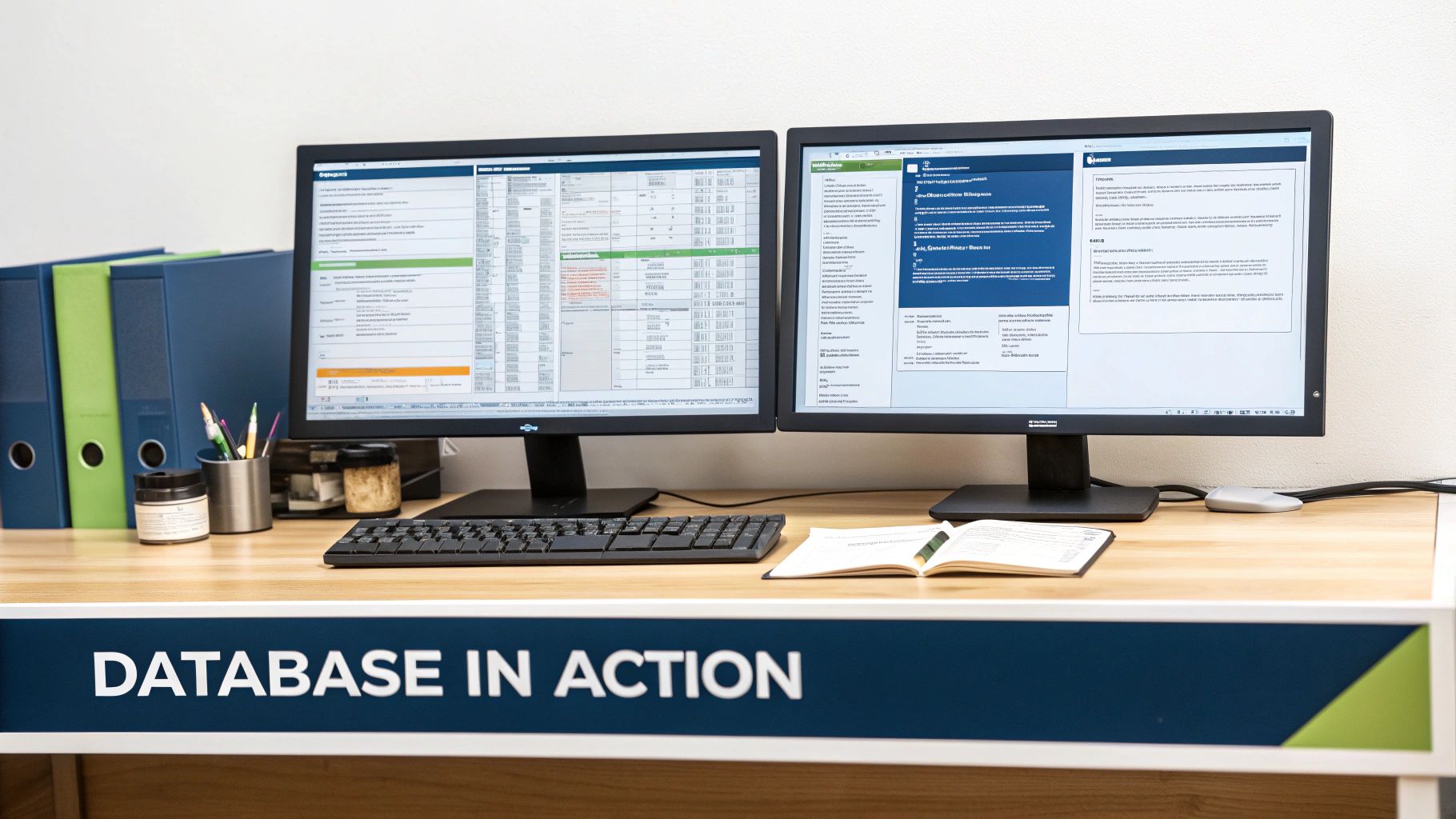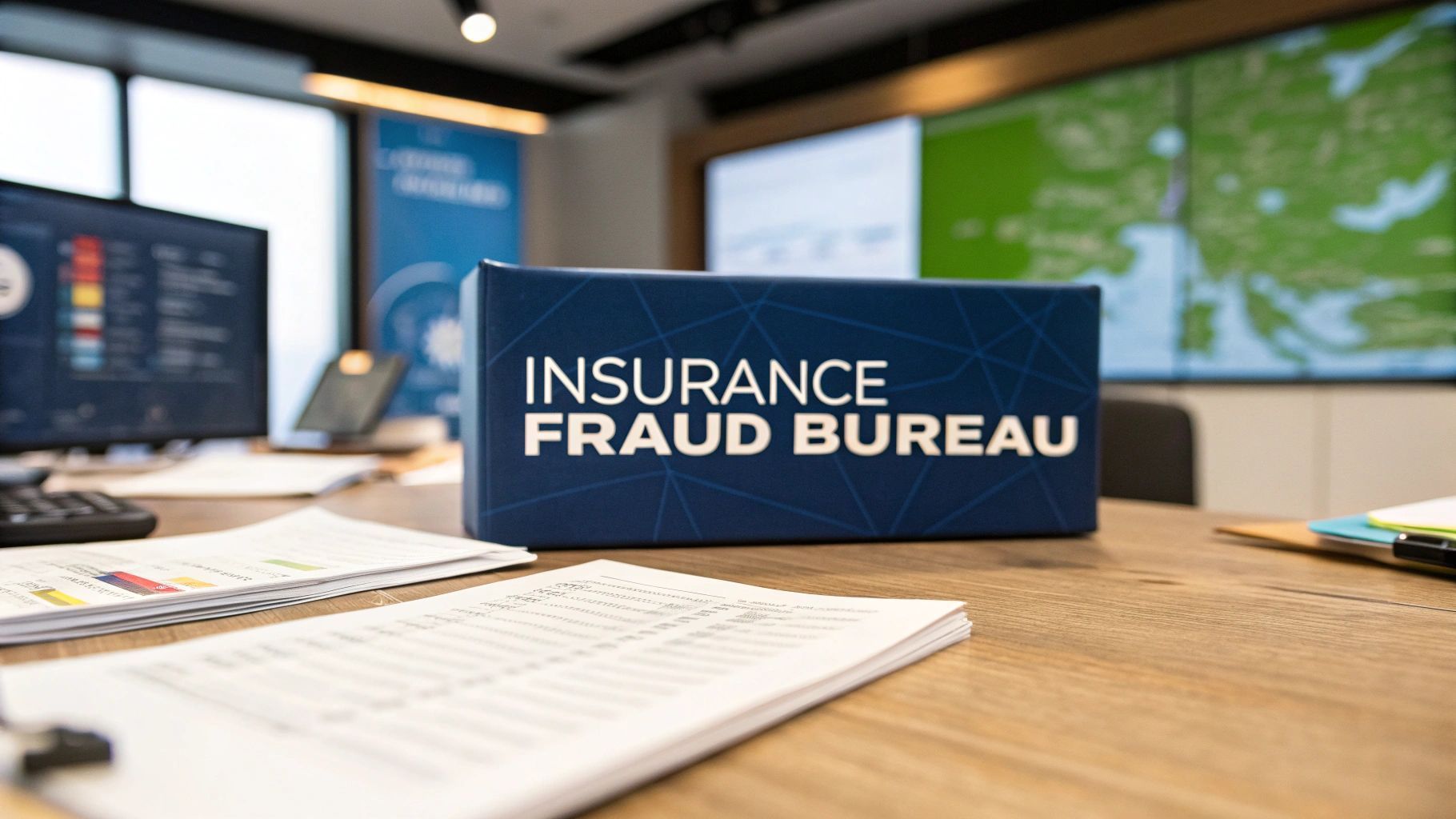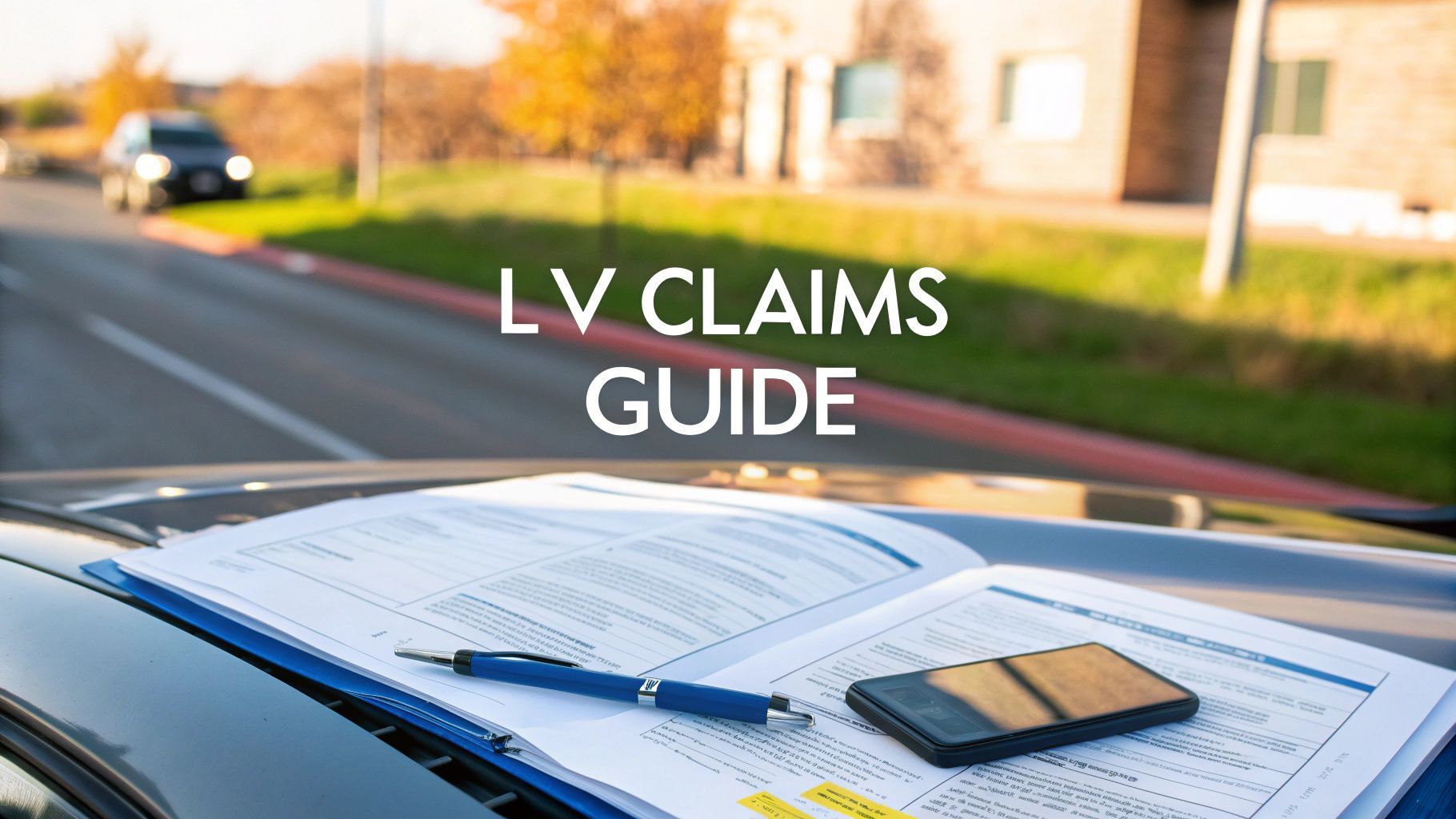insurance fraud prevention claims database: Key insights
Think of an insurance fraud prevention claims database as a neighbourhood watch for the insurance industry. It’s a secure, shared system where different insurers pool information about claims. This lets them spot suspicious patterns, hidden connections and fraudulent activities that would be impossible for a single company to see on its own.
This collective defence is crucial. It helps the industry identify organised scams and repeat offenders, ultimately protecting honest policyholders from the ever-rising costs of fraud which affects us all.
The Hidden Tax of Insurance Fraud on Honest Policyholders

Insurance fraud is often shrugged off as a victimless crime—a small fib to a big, faceless corporation. But that could not be further from the truth. In reality it acts like a hidden tax that every honest policyholder in the UK is forced to pay through higher premiums. When criminals file bogus claims those losses are not just absorbed by insurers; they get passed straight on to everyday families and businesses, increasing the cost of living for everyone.
The financial burden is staggering. Recent analysis paints a grim picture: a shocking one in seven claims (15%) is proven to be fraudulent. Even more concerning, the average value of a fake claim has ballooned to an eye-watering £84,000 . These are not minor exaggerations; they represent the sheer scale and audacity of modern fraud and highlight the challenge in ensuring a claim is provable.
To put the scale of the problem into perspective, here is a quick breakdown of the key figures from UK industry data.
The Real Cost of Insurance Fraud at a Glance
| Statistic | Figure | Implication for Policyholders and Insurers |
|---|---|---|
| Fraudulent Claims Identified | 1 in 7 (15%) | Insurers must invest heavily in detection and a significant portion of claims require extra scrutiny, raising costs for everyone. |
| Average Fake Claim Value | £84,000 | The high value of fraudulent claims directly inflates the overall cost pool, pushing up premiums for all policyholders. |
| Annual Cost to the UK | Billions of Pounds | These losses are absorbed into the system, contributing to the rising cost of living and business operations across the country. |
These numbers are not just statistics on a page; they represent real money being siphoned out of the system, forcing everyone else to pay more.
The Ripple Effect on Claims Processing
The damage is not just financial. Every fraudulent submission creates a ripple effect that slows down the entire claims system. Insurers have to divert huge amounts of resources—time, specialist expertise and technology—just to investigate suspicious activity. This creates a bottleneck, delaying payouts for genuine customers who have suffered a real, provable loss and are counting on that support.
Instead of focusing on settling claims for honest customers quickly and fairly, claims handlers get bogged down in complex investigations, meticulously checking details to separate fact from fiction. This defensive posture, born out of necessity, erodes trust and frustrates everyone involved.
Why a Unified Defence is Essential
This constant threat forces insurers to be cautious, which can sometimes penalise innocent policyholders caught in the crossfire. The problem has simply grown too big for any single company to tackle alone. Today’s organised criminal networks are sophisticated, often using advanced technology to cover their tracks, which demands a coordinated response from the entire industry.
Understanding the true cost of this problem is the first step. You can dig deeper into how these costs add up in our detailed article on what insurance fraud really costs the industry.
It is this urgent need for a unified front that highlights the crucial role of an insurance fraud prevention claims database . It is a tool designed to protect the integrity of the system and, most importantly, the financial interests of every single honest customer.
How a Claims Database Unites the Industry Against Fraud

Think of a claims database as a nationwide neighbourhood watch programme for insurers. It’s a secure, collaborative intelligence hub where crucial, anonymised information is shared across the industry. The goal? To build a united front against organised insurance fraud.
This shared approach is what allows insurers to finally see the bigger picture. A single company might only spot one suspicious claim and treat it as a one-off. But a shared database can instantly reveal that the same person, vehicle or address is linked to multiple similar claims across several different insurers. It turns isolated dots into a clear, actionable pattern.
The Power of Collective Intelligence
The principle is simple but incredibly powerful. When a new claim comes in it is automatically cross-referenced against millions of historical records from across the entire industry. This check happens in near real-time, creating the first and most formidable line of defence against would-be fraudsters.
Without this collective intelligence a criminal could try the exact same staged accident claim with five different companies and each insurer would be forced to assess it in a vacuum. With a shared database the system immediately flags the multiple submissions, revealing the fraud before a single penny is paid out.
A shared claims database acts as the industry's collective memory. It prevents criminals from exploiting the information gaps between individual insurers, ensuring that a red flag raised by one company serves as a warning to all.
This kind of shared insight is fundamental to tackling organised crime. Fraud rings thrive by spreading their activities across many providers to stay under the radar—a tactic that a unified database directly counters.
What Information Is Shared Securely
To maintain privacy and stick to strict data protection regulations like GDPR, the information shared is specific, relevant and anonymised. The point is not to pry into personal lives but to verify the legitimacy of a claim and establish that the loss is provable.
Key data points typically include:
- Claimant History: Previous claims an individual has made across all insurers.
- Incident Specifics: Details like the date, time and location of the incident.
- Involved Parties: Information on other individuals, vehicles or properties connected to the claim.
- Third-Party Connections: Links to solicitors, repair garages or medical professionals involved in the case.
This information is shared ethically and securely, with robust governance in place to protect consumers. The focus is always on identifying inconsistencies and suspicious connections that point to potential fraud, never on penalising honest customers.
The Mechanics of Data Matching
The engine that makes this all work is data matching . Think of it as a highly advanced version of a ‘spot the difference’ puzzle. The database software scans a new claim for key identifiers—a name, an address, a vehicle registration number—and instantly compares them against the vast historical dataset.
For example, if a claimant says they have a ten-year no-claims discount the system can cross-reference this against central records to confirm it. If a particular repair garage shows up on an unusually high number of dubious claims across different insurers the system will flag this connection for investigation.
This initial check is crucial. It acts as a powerful filter, separating the vast majority of legitimate claims from the tiny percentage that needs a closer look. By automating this verification, an insurance fraud prevention database does not just stop fraud; it also helps insurers fast-track genuine claims, ensuring honest policyholders get paid much more quickly.
The Key Data That Fuels Fraud Detection
An effective claims database is only as good as the information it holds. Think of it like a complex investigation where every shred of evidence, no matter how small, helps build the bigger picture. The system works by blending two distinct but complementary types of information: an insurer's own internal records and a rich variety of external data sources.
This combination is what allows the database to move beyond simple checks and start building a complete view of a claim's credibility and provability. It’s this fusion of what an insurer already knows with what the wider industry and public records can reveal that uncovers the inconsistencies fraudsters hope will stay hidden.
The Foundation: Internal Data
The first and most immediate source of information is an insurer's own history. Every policy ever written and every claim ever processed creates a valuable internal dataset. This information provides the initial context for any new claim and serves as the baseline for verification.
This internal intelligence includes:
- Policy History: Details of the policyholder's tenure, their cover levels and any mid-term adjustments they have made.
- Claims History: A record of all previous claims made by the policyholder, including dates, values and outcomes.
- Payment Records: Information on premium payments and any history of financial difficulty or missed payments.
By analysing this data an insurer can quickly spot anomalies. For instance, a customer with a long and spotless history is viewed very differently from a new policyholder who submits a high-value claim just days after their cover begins.
The Power of External Data Integration
While internal data is essential it is the integration of external sources that truly elevates a claims database into a formidable fraud prevention tool. This is where the collaborative power of shared intelligence comes into play, drawing on a wide network of verified information to validate the details of a claim. High-quality information is indispensable here, underscoring the critical role of data quality for business success.
Shared industry databases are a cornerstone of this approach. In the UK organisations like Cifas manage the National Fraud Database (NFD), a central repository of confirmed fraud cases submitted by its members. The scale of this problem is immense; the NFD recorded over 217,000 cases in just the first half of a recent year. A significant portion of these were related to false documents and a 25% surge in insurance sector filings highlights the growing threat, particularly with impersonation for motor insurance. The full scope of this issue is detailed in the findings from Fraudscape.
Unlocking Unstructured Data with AI
Beyond structured records a huge amount of intelligence is locked away in unstructured data. This includes things like engineers' reports, witness statements, digital images and even the geographic information embedded in photographs. Modern systems use artificial intelligence and machine learning to analyse this information for subtle red flags that a human might miss.
AI can detect inconsistencies in an engineer's report, identify digitally altered images or flag when a claimant's location data does not match the reported incident location. This transforms subjective documents into quantifiable risk indicators, strengthening the provability of a claim.
This capability is a game-changer. For example, analysis can reveal if the same descriptive language is being used across multiple, supposedly unrelated, claims reports—a classic sign of a coordinated fraud ring. You can explore our guide on how geo-location data strengthens insurance claims to see how this technology is applied in practice. By analysing every piece of the puzzle, an insurance fraud prevention claims database provides the comprehensive intelligence needed for every decision.
Evolving From Simple Checks to Predictive AI Analysis
Fraud detection has come a long way from the days of basic database lookups. The earliest systems were built on simple, rule-based checks, which were decent at catching the most obvious red flags — think duplicate claims or clear links to known fraudsters. While it was a crucial starting point, this approach could only ever spot the most basic attempts to cheat the system.
But as criminal tactics became more sophisticated and organised, so too did the methods needed to stop them. The industry quickly realised it needed tools that could see beyond individual claims to uncover the hidden networks connecting them. This was a major turning point, moving us away from straightforward data matching and towards far more dynamic, intelligent analysis.
Uncovering Hidden Networks
The next big leap forward was network analysis . The easiest way to picture this is as a detailed social network map for every single claim. It visually connects all the parties involved — claimants, witnesses, solicitors, vehicle repair shops and medical professionals — to reveal relationships that would otherwise stay hidden.
A single insurer might look at a claim involving a specific solicitor and a particular garage and see it as a one-off. But when a claims database pulls in data from across the entire industry it might suddenly discover that this exact solicitor-garage duo appears in dozens of similar, low-speed collision claims. This is a classic hallmark of an organised 'crash for cash' ring.
This is where network analysis really shines. It’s brilliant at exposing these organised fraud rings by spotting clusters of suspicious activity that, on their own, would seem completely unrelated. It connects the dots between isolated incidents to reveal the much larger, coordinated criminal operation lurking beneath the surface.
The infographic below shows how different data sources, from policy information and claims history to external records, all feed into a central database to build this complete picture.
This kind of visualisation demonstrates how a powerful insurance fraud prevention claims database draws intelligence from multiple streams to create a comprehensive view of risk.
Predicting Fraud Before It Happens
While network analysis is great for uncovering existing schemes the most advanced systems are now focused on prediction. This is where predictive modelling and artificial intelligence (AI) enter the picture, representing the true frontier of fraud detection today.
Predictive models are built using machine learning algorithms trained on enormous volumes of historical claims data. The system literally learns to recognise the subtle, complex patterns and traits that are common in fraudulent claims but are almost always missed by human analysts or simple rules.
By analysing thousands of data points in real time, a predictive model can assign a 'risk score' to every new claim the moment it’s submitted. This score instantly tells the insurer the statistical likelihood that the claim is fraudulent, allowing them to focus their investigative resources where they’re needed most.
The process is incredibly fast and sophisticated. The model might flag a claim based on a combination of factors that would never be picked up in a manual review, such as:
- The time of day the incident was reported.
- Tiny inconsistencies in the narrative of what happened.
- Distant connections to third parties with a history of suspicious activity.
The table below breaks down how these techniques have evolved, moving from basic matching to the more intelligent, analytical methods we use today.
Evolution of Fraud Detection Techniques
| Technique | How It Works | Example Application |
|---|---|---|
| Rule-Based Matching | Checks new claims against predefined rules and lists of known fraudsters or suspicious entities. | Flagging a claim if the claimant's address is on a watchlist or if a vehicle has been part of a previous claim in the last 30 days. |
| Network Analysis | Maps and visualises the relationships between all parties involved in a claim to identify hidden connections and organised rings. | Discovering that the same doctor, solicitor and repair shop are consistently involved in multiple, similar soft-tissue injury claims. |
| Predictive Modelling (AI) | Uses machine learning to analyse thousands of data points and calculate a real-time risk score indicating the probability of fraud. | Instantly flagging a new claim with a high-risk score based on a combination of factors like claim type, location and subtle narrative inconsistencies. |
This evolution shows a clear shift from reacting to known fraud indicators to proactively identifying and preventing potential fraud before it can cause financial damage.
For those looking to adopt these advanced capabilities to identify complex fraud patterns, exploring the best options for modern predictive analytics software can offer valuable insights into putting these sophisticated systems into practice.
By using predictive analytics insurers can essentially stop fraud at the front door rather than chasing it after the money has already been paid out. This proactive approach not only saves the industry billions but also helps protect the premiums of honest policyholders. It means fraudulent claims are stopped in their tracks, which in turn helps speed up the payment of genuine ones, improving the experience for everyone.
Seeing the Database in Action Against Real-World Scams

Theory is one thing but seeing how a shared claims database stands up to real-world fraud is where its true value becomes obvious. These systems are incredibly effective at exposing everything from small, opportunistic lies to sprawling criminal enterprises. Their power lies in connecting the dots between events that, to a single insurer, would look completely unrelated.
Let’s start with a common scenario: opportunistic fraud at the application stage. A driver might fib about their no-claims discount to get a cheaper premium. It seems minor but it’s still fraud. When the insurer runs the application against a central industry database that discrepancy is flagged in seconds. The policy can then be repriced correctly or even cancelled before a claim ever happens.
The same logic applies when a claim is made. Imagine a legitimate car accident but the claimant decides to pad the claim a little. They might add a few pre-existing scratches to the repair bill or overstate the value of personal items they say were damaged. A shared database helps spot this by flagging individuals with a history of similar, frequent or embellished claims, giving the handler a clear signal to dig a little deeper.
Exposing Sophisticated and Organised Crime
The real muscle of a collaborative claims database shows when it goes up against organised crime. These professional networks operate on a completely different level to individual opportunists and their methods are getting bolder. They often use stolen or entirely fabricated identities to take out policies with the single aim of staging accidents to make high-value fraudulent claims.
From one insurer’s perspective a claim might look perfectly legitimate. But the moment the details hit the shared database the system can instantly see connections that blow the whole operation wide open. For example, it might reveal the same solicitor, medical expert or repair garage is tied to dozens of similar claims across multiple different insurance companies.
This is where organisations like the Insurance Fraud Bureau (IFB) become indispensable. By managing and analysing data from across the industry, they can identify these hidden networks, disrupt criminal operations and provide law enforcement with the evidence needed for prosecution.
These criminal gangs are not just a financial drain; they are a genuine threat to the industry's stability. The money they make from insurance fraud is often used to fund other serious crimes, so shutting them down is a matter of public safety.
The Growing Threat of Identity Theft
A particularly worrying trend is the rise of identity theft within these criminal networks. Fraudsters use stolen personal data—often bought cheaply online—to pretend they are legitimate customers. They take out policies, submit bogus claims and leave the innocent victim to clean up the mess of having their name linked to fraud.
The Insurance Fraud Bureau has highlighted a dramatic surge in this area, with cases now over seven times higher than they were in 2021. Their analysis has even pinpointed hotspots for this activity, with West Yorkshire, Greater Manchester and the West Midlands topping the list in England. This data, combined with a 25% rise in fraud linked to identity theft and false applications, shows just how big the problem has become.
You can learn more about these UK policy fraud hotspots and the rise in identity theft. Without a centralised database, linking these seemingly separate events would be almost impossible, allowing these networks to operate freely and drive up costs for every honest policyholder.
Putting a Modern Fraud Prevention Strategy into Practice
Moving from theory to action means fundamentally changing how insurers tackle fraud. It’s no longer enough to react after the damage is done; the goal now is to build real-time risk assessment directly into your day-to-day operations. This involves bringing in an advanced fraud prevention platform that slots seamlessly into your existing claims and underwriting workflows.
By embedding an insurance fraud prevention claims database into these core processes, insurers can automatically vet submissions the moment they arrive. Think of it as a powerful, proactive defence that stops potential fraud at the front door, rather than chasing it after a payment has already been sent. The system acts as an intelligent filter, instantly analysing data to separate legitimate claims from those that need a closer look.
This approach delivers a powerful one-two punch that completely reshapes the claims experience. While its main job is to cut fraud-related losses, its positive impact on genuine, provable claims is just as important.
Speeding Up Genuine Claims and Improving the Customer Experience
When high-risk submissions are automatically flagged for an expert review it frees up your claims handlers to focus on what they do best: helping honest customers. The vast majority of claims, which are perfectly legitimate, can be processed and settled far more quickly. This speed and efficiency make a world of difference to the customer experience, especially when policyholders are often at their most vulnerable.
Instead of treating every claim with a hint of suspicion, insurers can fast-track the ones that are provably legitimate. This builds trust, boosts customer satisfaction and creates a real competitive advantage in a crowded market.
By automating that first-pass risk assessment the system makes sure human expertise is pointed exactly where it’s needed most. This optimises your resources and lets specialist fraud investigators concentrate on the complex cases that pose the biggest threat. The result? A more efficient, accurate and customer-focused operation.
A Strategic Investment in Business Resilience
Ultimately, investing in a modern fraud prevention strategy is about more than just defence. It’s a strategic move to build a more resilient, efficient and competitive business. By shielding the company from financial losses insurers can keep premiums more stable, which is a win for every honest policyholder. To learn more about how technology makes this possible, take a look at our insights on using insurance claims management software to streamline operations and combat fraud.
Implementing a robust platform powered by a shared claims database is an investment in the integrity of the whole insurance ecosystem. It protects honest customers from the financial burden of fraud, gets support to those in genuine need much faster and strengthens the business against increasingly sophisticated criminal threats. For any insurer looking to thrive this proactive stance is not just an option—it is essential.
We Answer Your Burning Questions
Whenever we talk about claims databases a few common questions always pop up, usually around data, privacy and whether the system is truly fair. It’s natural to be cautious, so let’s clear the air and address these points head-on.
The whole point of these databases is to spot the strange patterns that professional fraudsters leave behind, not to penalise honest people making a claim. By letting insurers securely compare notes on specific claim details—without revealing personal identities—we can collectively tackle a problem that ends up costing everyone more in the long run.
How Is My Personal Data Protected?
This is non-negotiable. Protecting personal data is not just a feature; it is the foundation of the entire system. Any information shared within a claims database is governed by strict data protection laws like GDPR. Where possible data is anonymised and access is locked down tighter than a bank vault, ensuring it is only ever used for legitimate fraud detection.
Think of it less like surveillance and more like a targeted fact-check. The system is designed to verify the specific details of a claim incident, not to pry into your personal life.
The entire framework is built on a principle called 'data minimisation'. This just means only the absolute minimum information needed to validate a claim and check for inconsistencies is ever shared. It’s a simple but powerful way to keep your privacy and security intact.
Will a Claims Database Delay My Genuine Claim?
It’s actually the other way around. One of the biggest wins of a modern claims database is its ability to speed up genuine claims . By using smart analytics to automatically flag low-risk submissions for approval, the system lets insurers fast-track the vast majority of honest claims.
Instead of treating every single claim with the same high level of suspicion this approach frees up human experts to focus their time on the tiny percentage of claims that show real red flags. For honest customers who just need help this means getting paid out much, much faster.
Is This System Fair to Honest Customers?
Yes, absolutely. The system is designed to protect honest customers from paying for the crimes of others. When fraudsters get away with a bogus claim those losses do not just disappear. They get passed on to everyone through higher premiums. An effective claims database puts a stop to that, helping keep costs fair for the honest majority.
By getting better at spotting and stopping fraud the industry can maintain fairer pricing and make sure money is always available to pay legitimate claims without delay. It’s all about protecting the integrity of the insurance system so it’s there for you when you actually need it.
Ready to see how a modern approach can shut down fraud and accelerate genuine claims? Proova provides the tools to build a more resilient and efficient claims process. Discover the solution.












